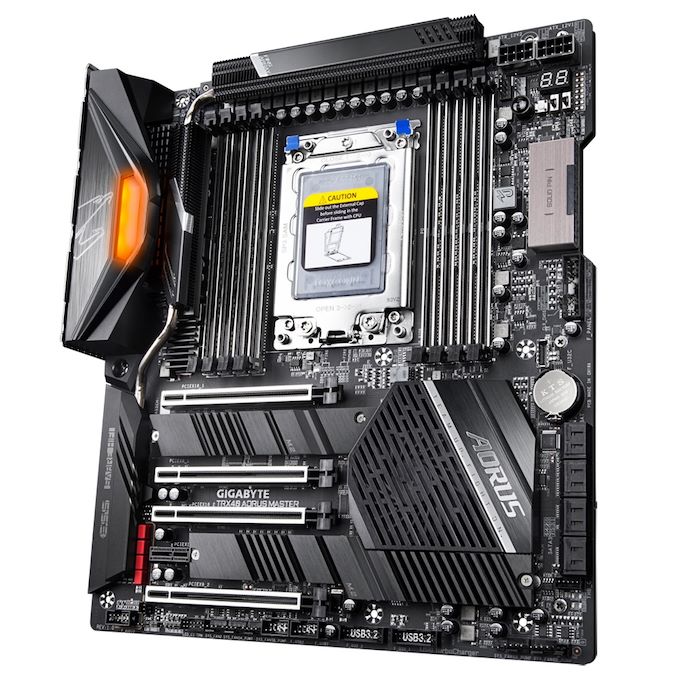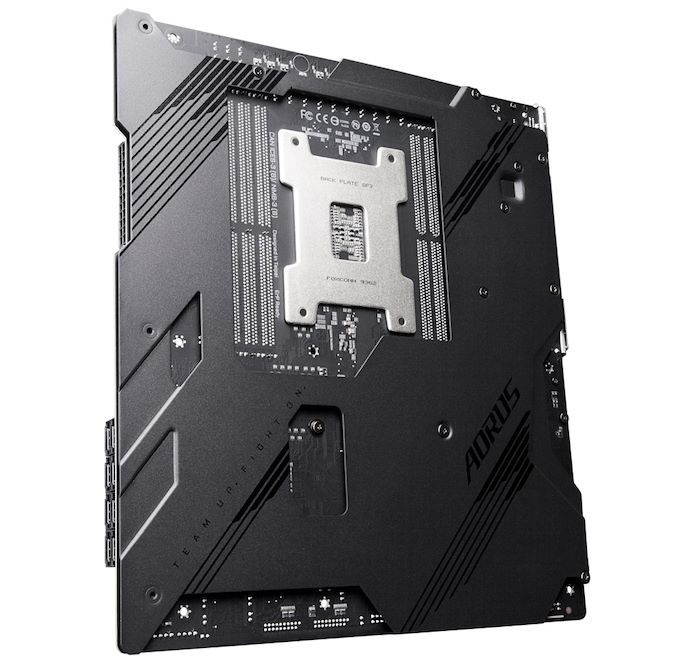The AMD TRX40 Motherboard Overview: 12 New Motherboards Analyzed
by Gavin Bonshor on November 28, 2019 9:00 AM EST- Posted in
- Motherboards
- AMD
- MSI
- Gigabyte
- ASRock
- Asus
- TRX40
- Threadripper 3000
- Castle Peak
GIGABYTE TRX40 Aorus Master
The GIGABYTE TRX40 Aorus Master sits below the TRX40 Aorus Xtreme in the product stack and combines a similar style, in a slightly smaller, but still larger than normal E-ATX PCB. Still retaining the high-end feel, the TRX40 Master is using an E-ATX PCB which is crammed with good quality controllers. The most notable features include support for DDR4-4400 and 256 GB, a pair of Ethernet ports on the rear panel including an Aquantia 5 G controller, Intel's AX200 Wi-Fi 6 wireless interface, and a beefy 16-phase CPU power delivery.
Starting from the top, the GIGABYTE TRX40 Aorus Master has eight memory slots in two banks of four on either side of the sTRX4 socket with support for DDR4-4400 and up to 256 GB in total. Taking a slightly more basic approach to the aesthetics, the rear panel cover does include integrated RGB LEDs, with black heatsinks on a black PCB. The large black aluminium power delivery heatsinks which are interconnected via a heat pipe are cooling a 16-phase power which consists of an Infineon XDPE132G5C 16-phase PWM controller, with sixteen Infineon TDA21472 70 A power stages. Providing power to the CPU is two 8-pin 12 V ATX power connectors which are located in the top right-hand corner.
Also at the top right-hand corner of the board is a two-digit LED debug, while below this is a right-angled 24-pin motherboard power connector. For PCIe devices, there are four full-length PCIe 4.0 slots which operate at x16/x8/x16+x8 and a single PCIe 4.0 x1 slot. The TRX40 chipset heatsink is actively cooled just as we saw with X570. For storage, the GIGABYTE TRX40 Aorus Master has three PCIe 4.0 x4 M.2 slots which include M.2 heatsinks for each slot, and there are eight SATA ports with support for RAID 0, 1, and 10 arrays.
Like with the GIGABYTE TRX40 Aorus Xtreme, the TRX40 Aorus Master also includes a large black metal backplate which will add extra weight to the board. The backplate displays the motto 'Team Up, Fight On' which is more of a gaming term, which is understandable given the boards Aorus branding. The TRX40 Aorus Master includes dual BIOS with a switch which allows users to select between the two, and for cooling, there is a total of eight 4-pin headers. These are split into one for a CPU fan, one dedicated for a water pump, and six for chassis fans.
On the rear panel are five USB 3.1 G2 Type-A, one USB 3.1 G2 Type-C, and two USB 2.0 ports. There are two Ethernet ports with one controlled by an Aquantia 5 G, and the other by an Intel Gigabit Ethernet controller. This model also includes Intel's AX200 Wi-Fi 6 wireless interface and also adds BT 5.0 connectivity too. To the left-hand side is a Clear CMOS and Q-Flash Plus switch, with the five 3.5 mm audio jacks and S/PDIF optical output handled by a Realtek ALC4050H and Realtek ALC1220 audio codec pairing. The TRX40 Aorus Master also includes a Realtek ALC4050H and ESS Sabre 9218 DAC for the front panel audio.
The GIGABYTE TRX40 Aorus Master is still a high-end TRX40 motherboard and with an MSRP of $499, it isn't exactly cheap, but it does offer users plenty of good quality features on AMD's new HEDT platform. While the Aorus brand is mainly targeted at gamers, the TRX40 Aorus Master looks to combine elements from both the enthusiast and gaming sides, to create a reasonably priced multi-purpose model for all looking to use and unlock all of the power within the Threadripper 3000 processors.













109 Comments
View All Comments
amb9800 - Saturday, November 30, 2019 - link
TB3 has not been open sourced. It's been royalty-free from the start, but any TB3 device still needs to be certified by Intel. Thus far the only TB3 devices that exist integrate Intel TB3 controllers, and very few non-Intel platforms have integrated TB3 (basically just a couple of X570 ASRock boards).Chaitanya - Friday, November 29, 2019 - link
In order to integrate Thuberbolt, Intel needs access to microcode which is why very few boards even on AM4 come with it and even those solutions are iffy at best.eek2121 - Friday, November 29, 2019 - link
Untrue, TB has been open sourced and will be a part of the USB 4.0 standard. The real answer is likely one I provided earlier: Intel CPUs have dedicated bandwidth for TB3, AMD CPUs hang it off the PCIE bus.amb9800 - Saturday, November 30, 2019 - link
TB3 being incorporated into USB 4.0 definitely does not mean it has been "open sourced." Every TB3 device must still be certified by Intel.ender8282 - Saturday, November 30, 2019 - link
I love the TB3 port on my laptop and docking station. It's way convenient. Honestly though I've never understood the use case on a desktop. If you've got an ATX motherboard and a decent sized case what need does it really solve?TechKnowbabble - Friday, December 20, 2019 - link
According to this video the GIGABYTE TRX40 AORUS XTREME has a Thunderbolt 3 header called THB_C, but on the site the only mention to this i can find is a "GIGABYTE add-in card connector" which the AORUS Master and Wifi Pro have mention of also. I dont know why it is listed differently from the Designare or not mentioned in this article but it appears that all the Gigabyte TRX40 boards support thunderbolt 3 with add in card.https://www.youtube.com/watch?v=o21xINJF1tE&fe...
NelsonK - Saturday, January 18, 2020 - link
It might as well be -BetaMax-. Thunderbolt is Intel's baby, and you gotta dance to their tune to get the engineering specs -- Intel doesn't publish 'em. Only well-resourced (i.e., volume) manufacturers can feasibly spend to design and incorporate it, then produce to a scale that justifies the investment. Sure, that's not precisely a licensing fee, but it's one heckuva barrier to entry.These firms can all afford it, but, since VHS (USB) is good enough, why bother? USB "3.2" is pretty darn close and even uses the same Type-C port. In fact, you can even play your VHS tapes on this BetaMax -- USB devices will run at their native speeds when connected to Thunderbolt.
And with USB 4, there will be no difference in speed. Is there even a practical difference in speed now? Do ya really need more than 10 Gbps? A few of you might, but not enough to pay the piper.
This is a no-brainer for the board makers: USB 3.1 Gen 2 ("3.2") Type-C offers a lot more speed than most devices can hope to keep up with internally. In the instances where somebody wants to daisy-chain video, they're either mining (which just needs the chain, not so much the speed), or they're using a laptop and don't have space for a video card. Well, these are mainboards, folks. You've got a bunch of fat-pipe PCIe 4.0 16-lane slots that your graphics cards won't even make full use of 99.99% of the time they're running, as they throttle down to 2.0 or 1.0.
BetaMax was better, but it died even before S-VHS was a real thing. ThunderBolt just got similarly voted down (massively) by pretty much all of big name manufacturers users trust enough and -might- have paid extra to get a board that has it.
Looks like we're goin' with VHS once again, boys and girls... ;-)
wilsonkf - Thursday, November 28, 2019 - link
Check your last page. Do you really mean "ASUS X570" Product Stack? Also other brands...gavbon - Thursday, November 28, 2019 - link
Good spot Wilson, I really appreciate it. I've been neck-deep in X570, I must have been in AM4 mode!tamalero - Thursday, November 28, 2019 - link
hey Anana, any chance you could build a full comparison table between number of ports, pci-e slots, wifi, ethernet..etc..?